24/03/2015 - Start Fly Fishing
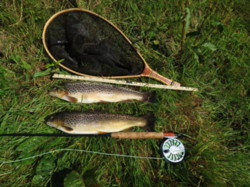
A brace of brown for the table,
As I walked through the riverside copse, Ramson with its white flowers were prolific, often confused as wild garlic, along the hedgerow bluebells were about in profusion also the trees were getting their full cloaks of green, coming out of the wood into Johnson’s meadow and the bright sunshine, I stopped to put on my Polaroid glasses then slowly walked upstream for about six hundred yards to reach Swallow Pool which is over hung by a large oak tree, the river flowed crystal clear over small stones with an occasional rock; it was a friendly bit of wading water. Sitting on the bank I soaked up the warm sunshine taking in the riverside beauty, a few feet downstream a beautiful clump of marsh marigolds looked resplendent as they glistened in the bright sunshine, along with the primrose and snowdrops these plants are the first to offer some bright colour to the countryside, the start of the river brown trout fishing in Lancashire March 15th also sees the first of the primrose unless it’s very mild then this delicate flower is often in bloom by March 1st Towards the far bank at the bottom of the pool a good fish swirled on the surface. It was time to make a cast.
Moving downstream so I was below the rising fish I sat down close to the water’s edge then pulled off enough line to cover the fish, with two false casts the line flew silently over the water unfurling as it did so, the imitation olive landed like thistledown, making a small upstream mend I retrieved line as the olive drifted very lifelike downstream, within a few feet the fly disappear as a dimple appeared on the surface. Lifting the rod smoothly I set the hook then felt the surge as a fish fought for its freedom, the pressure of balanced tackle soon took its toll as I pulled the fish close to hand. Bending down I eased the fly from the scissors of a nicely marked brown trout, in seconds it was streaking off to the deeper water. Just a few moments of fly fishing from my diary.
I must say from the start fly fishing is about timing, it’s not a muscle game, which is where many men make their mistake, during the years I had my fly fishing school in the UAE I had many lady pupils who outcast the men on many occasions, ladies will listen, take notice practice and don’t know it all after a day. I well remember a couple from Qatar, I was teaching the class how to use the Tie-Fast tool, for joining different thickness of line in this case 20lb to 50lb its also used for joining backing or leaders to the fly line, after fifteen minutes, I tested the knots all were perfect except the knot tied by the male pupil from Qatar which busted under light pressure. I asked why he hadn’t used the Tie Fast Tool? being told “I don’t need to tie knots” using a tool, after tying several knots which all busted, he eventually used the tool, his knots were perfect. Many of the ladies who I teach to cast a fly, do so either to join their husband at the waterside or because the partner plays golf, which they consider boring.
What Does It Cost?
The answer is as little or as much as you want to spend within reason, you can get a decent rod, reel and line for around a £100-00, cheaper if you can find a decent second hand outfit, though you will need to have someone with the knowledge of fly fishing. I suggest you choose a 9 foot rod rated for a 6 weight line, its most important that you match the line weight as described written on the butt joint just above the cork handle, you will see AFTM 9ft # 6 line, so make sure you have a # 6 rated line for the rod, you need to aerialize 30 feet of line extended from the rod tip to load the rod. A company that does very good rods, reels and fly lines ideal for the newcomer or improver that will suit most anglers wallets are Shakespeare, my advice is visit a local shop where an assistant goes fly fishing, also ask to try two or three rods to see what model suits you best. I usually teach my pupils with a progressive action rod, don’t go for a stiff action rod they are for the experienced fly fisher often for use in windy conditions on the flats when hunting bonefish where you need to tight casting loops. A progressive or soft action rod will help your casting, should you make a mistake that slower action rod will often help you get away with it. As a member of Thomas & Thomas pro-staff I have for the past 4 years been using fibre glass rods from the company, they have the action of cane, the weight of carbon, making them perfect for dry fly fishing also giving me lots of pleasure. Most casting instructors will have a variety of models for you to try, the average cost for a lesson is around £30-00 an hour, certainly worth the investment, for an hours instruction from a competent casting instructor. Whatever you do don’t ask your best friend to teach you, unless he has a good knowledge of teaching the art of fly fishing, otherwise when you go for a lesson the teacher will spend time correcting the mistakes, I’m quite happy to teach Lone Angler readers living in the North of England, all I ask for is a cheque made out to one of my charities.
A fly fishing reel for brown and rainbow trout fishing is just a reservoir for holding fly line and backing, you should get a reel for around £20-00, the most important part of the outfit is the line, probably the most used line profile is a weight forward, often described WF followed by the line weight. Also pay as much as you can afford, but don’t skimp on the price of the fly line it really is the most important part of your kit. You will then need a few knotless tapered leaders around 9 feet in length with a tippet of 3lbs for stream fishing probably 6lb for reservoirs, the tippet is the fine end of the tapered leader. I often use a leader of 15 feet in low gin clear water. At some time it will be suggested you use a braided leader loop on the end of your fly line for attaching the leader, forget this advice, you will do better by attaching leader direct to fly line. Some fly fishers use straight nylon, please don’t go down that rout, tapered leaders give you a better presentation, also allow the leader to roll out giving a better presentation of the fly on the water ensuring good fly presentation.
Some Flies
We all have far too many flies, I have literally thousands collected over a lifetime of fishing many not suitable for fishing, not many anglers can go in a fly fishing shop without buying another couple of flies. I reckon a selection of 10 barbless patterns in a couple of sizes for each pattern would be suitable for the newcomer. Pat O’Reilly author of Matching the Hatch is a book that I can recommend. My selection would be the following which are all imitative patterns, my first choice would be Chironomids, known as midge Pupa or buzzers a nonbiting midge, it’s a very popular pattern on still waters. Though it isn’t used enough by anglers fishing rivers and streams, I have caught lots of brown trout fishing this pattern often down to size 22, in the States they will use this pattern on a size 28 hook, no chance for me I have a job at times tying on a size 22. I suggest size 14 and 16 in two colours, black and red patterns, in April I would want some Grannom a Caddis fly in sizes 12’s and 14’s Greenwell’s Glory, Gold-Ribbed Hare’s-Ear, Pheasant tail nymph, Large dark olive, Klinkhammer Iron blue dun and Blue-winged Olive all in sizes 12-14’s. I always advise my pupils to ask in the local fly shop on pattern selection and size as it can vary from river to river and time of the season.
Odds and Ends
You will need some fly line cleaner, I use ArmorAll available from Halfords or similar shops, a large bottle will cost around £5-50, a small bottle of fly line cleaner between £8-£10. You will need some float ant to keep your dry flies floating, I use both Gerks Gink and Dry shake. For degreasing the end of the leader so it cuts through the surface film I make up a mixture of fuller’s earth and washing up liquid into a paste keeping it in a small plastic shot box, a small pair of forceps are useful for the odd fish hooked well inside the mouth, if its deeply hooked I cut the line as close to the hook as possible, on no account squeeze the fish around the stomach, trout are very fragile creatures. Hopefully this short article has wetted your appetite to try fly fishing, remember it’s no more difficult that other forms of angling it’s just different. Feel free to e-mail me with any questions you might have [email protected]
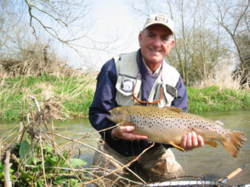
Fly fishing techniques also help you catch big trout from rivers.
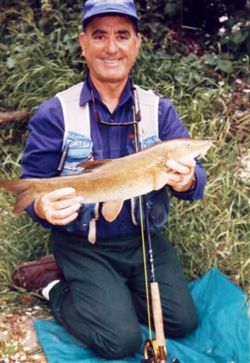
My first barbel on Richard Walker mayfly nymph from River Teme, that day I had 8 barbel when several anglers fishing meat had the odd fish, at the time there was a big hatch of mayflies.
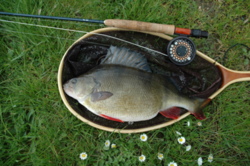
This Kennet perch was caught on a small nymph.
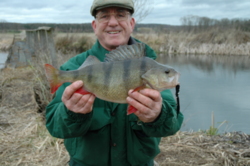
Kennet perch caught when fly fishing for pike.
Back to the News List












